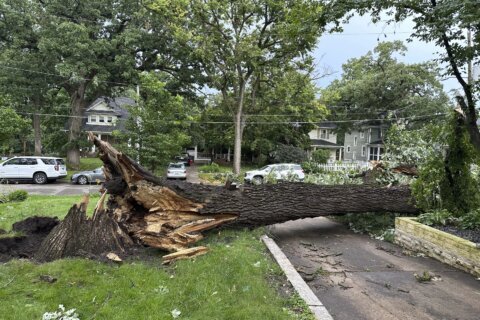HUDSON, N.Y. (AP) — The race is on to keep a 150-year-old lighthouse from crumbling into the Hudson River.
Wooden pilings beneath Hudson-Athens Lighthouse are deteriorating, and the structure, built in the middle of the river when steamboats still plied the water, is beginning to shift. Cracks are apparent on the brick building and its granite foundation.
While there are other endangered lighthouses around the nation, the peril to this one 100 miles 161 (kilometers) north of New York City is so dire the National Trust for Historic Preservation placed Hudson-Athens on its 2024 list of the country’s 11 most endangered historic places. Advocates say that if action isn’t taken soon, yet another historic lighthouse could be lost in the coming years.
“All four corners will begin to come down, and then you’ll have a pile of rock in the middle. And ultimately it will topple into the river,” Van Calhoun of the Hudson-Athens Lighthouse Preservation Society said during a recent visit.
The society is trying to quickly raise money to place a submerged steel curtain around the lighthouse, an ambitious preservation project that could cost as much as $10 million. Their goal is to save a prominent symbol of the river’s centuries-long history as a busy waterway. While the Hudson River was once home to more than a dozen lighthouses, only seven still stand.
Elsewhere, there’s a similar story of lost history.
Across the United States, there were around 1,500 lighthouses at the beginning of the 20th century. Only about 800 of them remain, said U.S. Lighthouse Society executive director Jeff Gales. He said many of the structures deteriorated after they were automated, a process that became more common by the 1940s.
“Lighthouses were built to have human beings taking care of them,” Gales said. “And when you seal them up and take the human factor out, that’s when they really start falling into disrepair.”
The Hudson-Athens Lighthouse began operating in 1874 offshore from the city of Hudson and was eventually co-named for the village of Athens on the other side of the river. It was built to help keep boats from running aground on nearby mud flats, which were submerged at high tide.
“There were shipwrecks because they couldn’t see the sandbar. And so that’s why this lighthouse was put in the middle of the river, unlike most that are on the shoreline,” said preservation society president Kristin Gamble.
The lighthouse is still in use, though now with an automated LED beacon. The preservation society owns the building and maintains it as a museum.
The last full-time keeper, Emil Brunner, retired in 1949 when the lighthouse became automated. He lived there with his family for much of his tenure. One of his daughters recalled rowing to school and, in the winter, walking across the ice on a safe path marked by her father’s tobacco juice stains on the frozen surface. Brunner also is portrayed on a 1946 Saturday Evening Post cover painting rowing with a child, Christmas presents and a tree in tow, as his wife and other children await their arrival on the lighthouse landing.
Visitors who are ferried to the lighthouse today can explore the keeper’s quarters, which are modest but feature river views from every window. And they can climb up the tight spiral staircase to the tower to take in a unique panorama view of the river and the Catskill Mountains to the west.
Roof work on the lighthouse is underway this summer, but repairs to the building will ultimately mean little unless workers address damage to some of the 200 wood pilings packed in mud that hold the lighthouse above water. The support structure has weathered 150 years of currents and ice. But large commercial ships of the modern era — with their big propellors — introduce new problems.
“They create a turbulence that’s like being inside a washing machine. And that turbulence actually comes underneath and pulls — churns up — the soil underneath us and sucks it away,” Calhoun said. “In fact, there are boulders as big as your car that are 100 feet out in that river that used to be right next to us.”
The underwater agitation washes away mud around the pilings, leaving them exposed to water. And that accelerates decay of the wood. Engineers estimate the structure could begin to tilt in three to five years, which Gamble said would be “the beginning of the end.”
The proposed ring of corrugated steel would shield the structure from that turbulence. The 100-foot (31-meter) diameter circle, which would project above the water line, would be filled in and covered by a deck, enlarging the area around the lighthouse.
The preservation group is optimistic about getting federal money to help pay for the project. Both of New York’s U.S. senators, Democrats Chuck Schumer and Kirsten Gillibrand, support the effort, as does local Republican U.S. Rep. Marc Molinaro.
Though the project is pricey, Gamble said, it would not only save the lighthouse from being lost to time, but it would also protect the 19th-century beacon for generations to come.
“We need, basically, the 100-year fix,” she said.
Copyright © 2024 The Associated Press. All rights reserved. This material may not be published, broadcast, written or redistributed.







